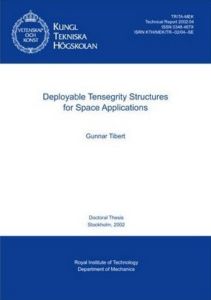This thesis deals with the development of deployable structures, based on the tensegrity
concept, for applications in space.
A state-of-the-art review of deployable masts and reflector antennas for space applications
is presented. A comparison is made between the various reflector antennas
in terms of deployed and stowed sizes, mass and accuracy.
The key step in the design of tensegrity structures is the form-finding analysis.
Several methods proposed for this step are scrutinised and classified into two groups,
kinematic and static methods, and the advantages and disadvantages of each method
are investigated. Two of the statical methods seems to be identical. It is concluded
that several form-finding methods are available, but no single method is suitable for
general tensegrities. The force method, for the analysis of the kinematic and static
properties of large bar frameworks, is presented.
The analysis and design of deployable tensegrity masts, with three struts per stage,
is described. A routine for the manufacturing of physical models is proposed and
evaluated. Different schemes for deployment are investigated. A way to deploy
the struts using self-deployable hinges is introduced and demonstrated by four- and
eight-stage mast models. Finally, the tensegrity mast is compared with an existing
deployable mast with respect to stiffness. The mast is relatively stiff in the axial
direction but very weak in bending.
The requirements for a deployable reflector antenna used on small satellites are
formulated. A concept, which uses a triangulated cable network to approximate
the reflecting surface, is adopted. The kinematically determinate triangulated cable
network is thoroughly analysed. The achievable surface accuracy of the net,
both to systematic errors arising from the triangular approximation of the surface
and random manufacturing errors, is evaluated. The underlying principles and the
statical and kinematical properties of the new concept are presented. A physical
model is built to analyse the feasibility of the concept and to test various deployment
schemes. The scheme using telescopic struts are identified as the most suitable
and a preliminary design an antenna, with a diameter of three metres, for a future
space mission is performed. Numerical computations show that the antenna is stiff
and extremely light.
In Collection
#7721
Read It:
Yes
#7721
Read It:
Yes
|
|
||||
